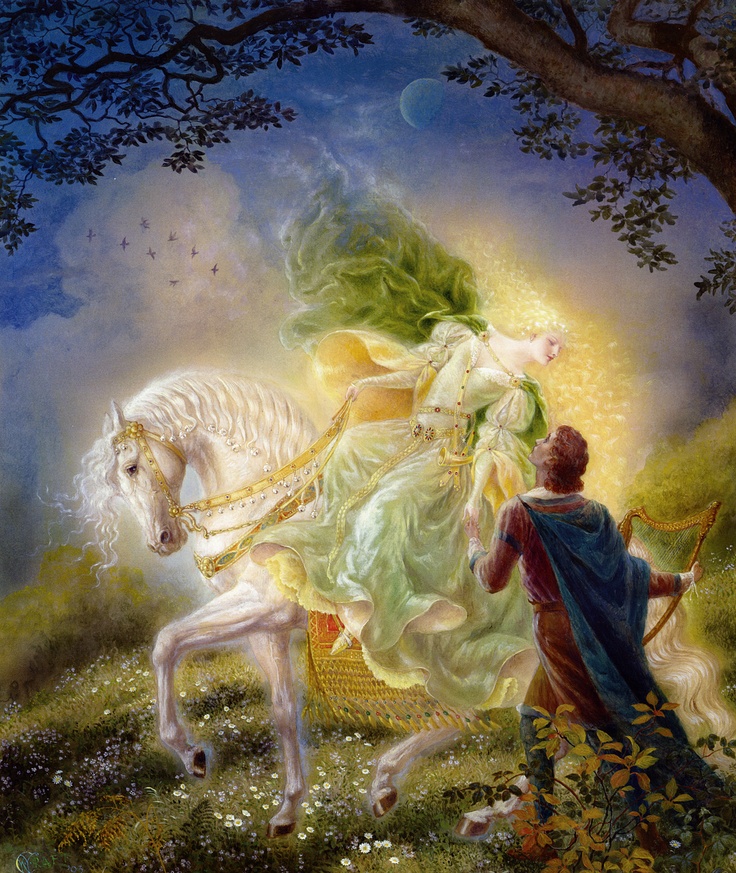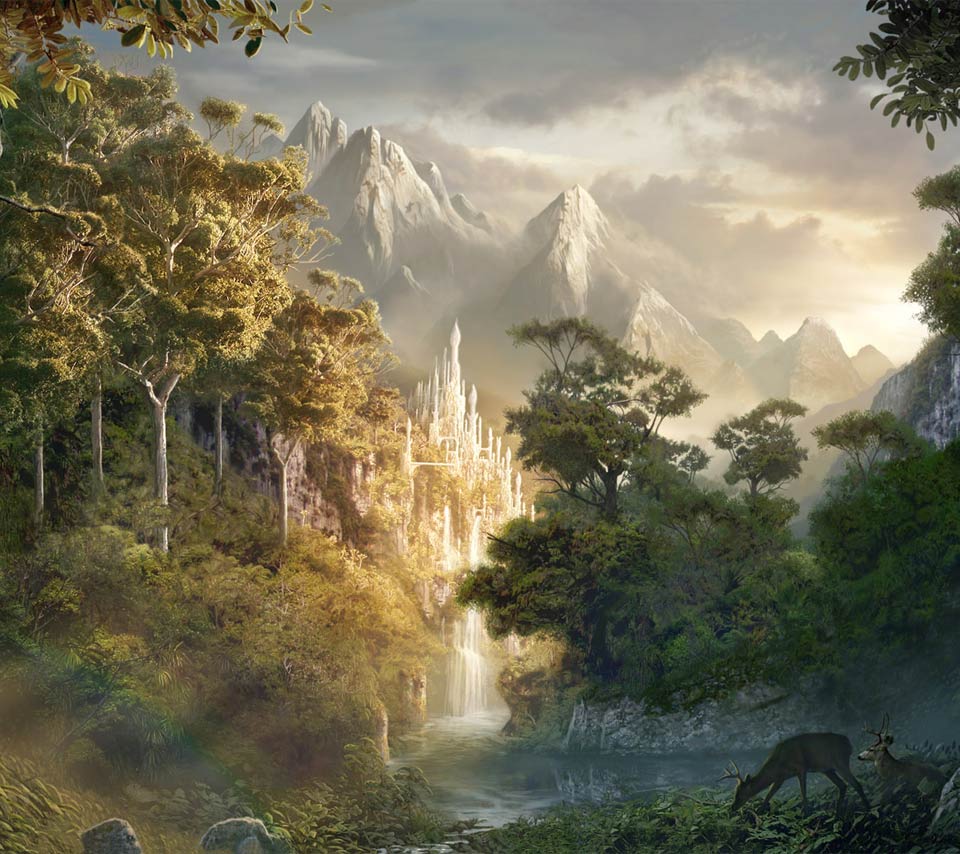Secondo i Celti Altrove è la Terra della felicità eterna dove vivono gli uomini dopo la vita sulla terra: dove non ci sono peccati da espiare o buone azioni da premiare; dove vivere una vita piena e perfetta e non una non-vita come quella immaginata dagli antichi Greci o dai Romani.
«Le ombre non raggiungono il soggiorno silenzioso dell’Erebo e i pallidi regni di Dis Pater, poiché lo stesso spirito governa un corpo in un altro mondo» (Lucano, Farsaglia, III, 399-400).
Altrove è la terra dove vivono gli antichi dei, ovvero è il Regno delle Fate (Elfland): ciò che i Cristiani chiameranno Paradiso, che però per i Celti non sta in Cielo bensì in un’altra dimensione sulla Terra.
In Irlanda Altrove si trova sottoterra, dentro ai tumuli megalitici (sidh) dove vivono i Tuatha Dé Danaan, i popoli della dea Dana, già signori dell’Irlanda prima dell’arrivo dei Gaeli.
E tuttavia il mondo sotterraneo di Altrove non ha nulla di Oscuro e tenebroso, anzi è esattamente identico al mondo di sopra ma “migliorato”, con un clima sempre sereno e una temperatura confortevole, e una natura rigogliosa e generosa nei suoi frutti. Un luogo dove vivere una vita migliore e serena.
L’Altro Mondo viene descritto diffusamente nei racconti celtici come una terra meravigliosa. Altrove è un isola oltre il mare (o sotto il mare) situata simbolicamente ad Ovest
Terra di giovinezza e terra di vita
terra priva di dolore
lontana nell’occidente dorato
sulla riva del mare azzurro…
la terra dalle valli verdeggianti
priva di morte e di dolore
dove è sempre estate
Sebbene Altrove si raggiunga solo con la morte, alcune leggende e poesie celtiche narrano di poeti, eroi semi-divini o semplici visitatori che ci sono arrivati in vita; alcuni sono imram ovvero racconti di avventure per mari inesplorati, altri rientrano nel vasto tema popolare del rapimento fatato.

Così nella narrazione di Thomas of Erceldoune (Ercildoune) riportata nel Thornton Manuscript, il bardo scozzese meglio noto come Tommaso il Rimatore (Thomas the Rhymer), rapito dalla regina delle Fate nella foresta di Ettrick, descrive Altrove come un reame dell’abbondanza dove dame e cavalieri si dilettano con musica, danze e canti, schermaglie amorose e giochi cortesi (senza omettere sontuosi banchetti) (48-52)
Traduzione italiana Francesco Saba Sardi
48
Entrò con passo lieve nella sala
E Thomas lo fece insieme a lei.
Poi dame vennero ed erano gentili
E a lei per cortesia si inginocchiarono.
49
Arpa e violino suonarono allegri
E con essi la cìtara e il salterio
E si unirono il liuto e la ribecca
E menestrelli presero a cantare.
50
Ma la cosa che fu più straordinaria,
Pensò Thomas intento a riguardare,
Furono i cervi, cinquanta, lì imbanditi,
Ed erano tutti grandi e ben pasciuti.
51
Il sangue i cani stavano lappando
E i cuochi vennero con i coltelli
E presero a tagliare come matti
E parevano in preda a frenesia
52
Cavalieri danzavano a tre a tre;
C’era baldoria, c’era festa e gioco;
Belle dame raccolte in lieta schiera
Ben abbigliate cantavano in coro.
NOTE
(tratto da Hugh Mynne, La via delle Fate, Sperling & Kupfer, Milano 1998)
La storia oltre a essere raccontata in un romanzo medievale è finita in una ballata popolare scozzese “Thomas Rymer and Queen of Elfland”.
[English version]
According to the Celts Elsewhere (Otherworld) is the Land of eternal happiness where men live after life on earth: where there are no sins to expiate or good deeds to reward; where to live a full and perfect life and not a non-life like the one imagined by the ancient Greeks or Romans.
.. according to your teaching the Shades do not make their way to the still regions of Erebus or the grey realm of Dis below; the same spirit guides a new body in another world (Lucan, Pharsalia, III, 399-400).]
Elsewhere is the land where the ancient gods live, that is the Kingdom of Fairies (Elfland): what the Christians call Paradise, but for the Celts it is not in Heaven but in another dimension on Earth. In Ireland Elsewhere it is located underground, inside the megalithic mounds (sidh) where the Tuatha Dé Danaan live, the peoples of the goddess Dana, former lords of Ireland before the arrival of the Gaels.
And yet this underground world has nothing dark and gloomy, indeed it is exactly identical to the world above but “improved” with an always serene climate and a comfortable temperature, and a luxuriant and generous nature in its fruits. A place to live a better and serene life.
The Other World is widely described in Celtic stories as a wonderful land, Elsewhere is an island beyond the sea (or under the sea) located symbolically in the West
Land of youth and land of life
earth without pain
far in the golden west
on the shore of the blue sea …
the earth from the green valleys
free of death and pain
where it is always summer.
Although Elsewhere can only be achieved by death, some Celtic legends and poems tell of poets, semi-divine heroes or simple visitors who got there in life; some are imrams or tales of adventures for unexplored seas, others are part of the vast popular theme of the fairy abduction.
Thus in the narration of Thomas of Erceldoune (Ercildoune) reported in the Thornton Manuscript, the Scottish bard better known as Thomas the Rhymer, kidnapped by the fairy queen in the Ettrick forest, describes a realm of abundance where ladies and knights they delight in music, dance and song, amorous skirmishes and courtly games (without omitting sumptuous banquets) (48-52)
48
In-to þe haulle sothely scho went,
Thomas foloued at hir hande;
Than ladyes come, bothe faire and gent,
With curtassye to hir knelande.
49
Harpe and fethill bathe þay fande,
Getterne, and als so þe sawtrye;
Lutte and rybybe bothe gangande,
And all manere of mynstralsye.
50
Þe most meruelle þat Thomas thoghte,
Whene þat he stode appone the flore;
Ffor feftty hertis in were broghte,
Þat were bathe grete and store.
51
Raches laye lapande in þe blode,
Cokes come with dryssynge knyfe;
Thay brittcned þame als þay were wode;
Reuelle amanges þame was full ryfe.
52
Knyghtis dawnesede by three and three,
There was revelle, gamene and playe;
Lufly ladyes, faire and free,
That satte and sange one riche araye.
The story as well as being told in a medieval novel ended up in a Scottish folk ballad “Thomas Rymer and Queen of Elfland”

La Terra della Giovinezza
Sulla falsariga dei rapimenti fatati della tradizione celtica ieri come oggi si scrivono canzoni. La fata canta con parole seducenti il suo richiamo verso il bel mortale invitandolo a seguirla nella Terra della Giovinezza (in gaelico irlandese Tír na nÓg): un’isola meravigliosa (che nel ciclo arturiano prende il nome di Avalon) o una grande pianura dentro i tumuli preistorici, dove corrono i cavalli, le donne sono bellissime, i frutteti sono rigogliosi, la musica è soave, il tempo eternamente sereno, il guerriero celta che muore eroicamente in battaglia è certo di essere accolto ad Altrove.
Along the lines of the fairy raptures of the Celtic tradition, today, like yesterday, some songs are written. The fairy sings with seductive words his call to the beautiful mortal inviting him to follow her in the Land of Youth (in Irish Gaelic Tír na nÓg): a wonderful island (which in the Arturian cycle takes the name of Avalon) or a great plain inside the prehistoric mounds, where the horses run, the women are beautiful, the orchards are lush, the music is sweet, the weather is eternally serene, where the Celtic warrior who dies heroically in battle is sure to be welcomed.
Chorus (1)
Sha ta co ti oh scum ne rivna
Sha ta co ti oh nugga Tír na nÓg
Sha ta co ti oh scum ne rivna
Nug a Tír na nÓg
I
Come my love our world’s may part
The gods will guide us across the dark
Come with me and be mine my love
Stay and break my heart
II
From the shores through the ancient mist (2)
You bear the mark of my elven kiss
Clear the way (3), I will take you home
To eternal bliss
bridge
Tír na nÓg, oh
Come beyond the ancient fog
Tír na nÓg, oh
Come with me to Tír na nÓg
III
Far away from the land you knew
The dawn of day reaches out to you
Though it feels like a fairy tale
All of this is true
IV
Run with me, have a look around
We build our life of a sacred ground
Come my love, our world’s may part
We’ll be safe and sound
V
Dawn won’t follow the path we came
The world you left, it forgot your name
Stay with me and be mine my love
Spare my heart the pain
FOOTNOTES
1) the choir is written in Tolkien’s elvish languages, see notes by Stephen Salzano
2) it is the magic fog that envelops the world of fairies, the fogs of myth and nostalgia
Traduzione italiana Cattia Salto
Sha ta co ti oh scum ne rivna
Sha ta co ti oh nugga Tír na nÓg
Sha ta co ti oh scum ne rivna
Nug a Tír na nÓg
I
Vieni mio caro, a far parte del nostro mondo
gli dei ci guideranno tra l’oscurità
vieni con me per diventare mio, mio caro
resta e mi spezzerai il cuore
II
Dalle spiagge attraverso la nebbia del tempo
porti il marchio del mio bacio fatato,
spiana la strada, ti porterò nella casa
dell’eterna beatitudine
(ponte)
Terra della Giovinezza
vieni oltre la nebbia del passato
Terra della Giovinezza
vieni con me nella Terra della Giovinezza
III
Lontano dalla terra natia
la vecchiaia non ti raggiungerà
anche se sembra una favola
è tutto vero
IV
Corri con me, dai un’occhiata in giro
Costruiremo la nostra vita su una terra sacra,
vieni amore mio, a far parte del nostro mondo
staremo al sicuro e in salute
V
Il tempo non seguirà il sentiero che prenderemo
il mondo che abbandoni, dimenticherà il tuo nome, resta con me per diventare mio,
risparmia il mio cuore dal dolore
NOTE
(1) (da qui) che in italiano significa: O bello mio, vieni con me nel Regno delle Fate
(2) è la nebbia magica che avvolge il mondo delle fate, sono le nebbie del mito e della nostalgia
(3) equivalente all’espressione italiana “fare largo”
Celtic Woman&Oonagh – Tír na nÓg in Destiny 2016.
LINK
post sviluppato dal precedente articolo
http://ontanomagico.altervista.org/otherworld.htm
http://ontanomagico.altervista.org/druido.html
http://www.academia.edu/31603072/Changing_Celtic_concepts_of_the_Otherworld_and_Afterlife
https://axismundi.blog/2018/03/23/jean-markale-laltro-mondo-nel-druidismo-e-nel-cristianesimo-celtico/
https://bifrost.it/CELTI/4.Eriuiltempoelospazio/05-Soprannaturale.html
http://bifrost.it/Studi/Confluenza.html
